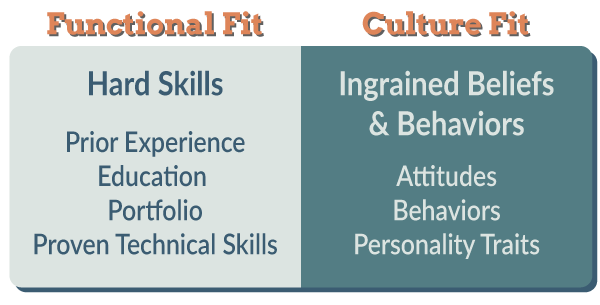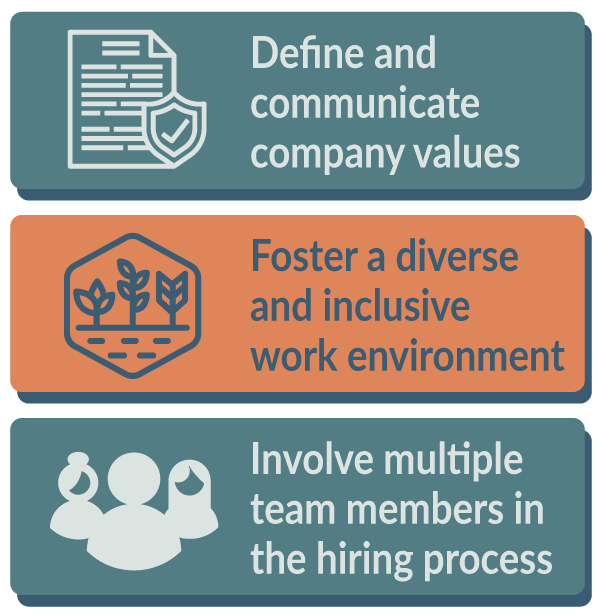Whenever you’re looking for a new employee to join your ranks, it’s standard to assess their ability to do a job, reviewing things such as experience, skills and education. However, another factor you should consider carefully is how they fit into your culture.
A culture fit occurs when an employee’s values, attitudes and behaviors align with their company’s. Because it directly impacts morale and productivity, culture fit is essential when hiring someone new.
Definition of culture fit
Culture fit involves assessing a company’s values and ideals, and comparing them to those of a potential employee. Workers with similar values or attitudes are usually a good culture fit since they’ll be more receptive to the company’s workflow, policies and initiatives. However, those with wildly different values may not align well in the work environment. In some cases, they can even be a detriment to the organization.
As such, managers should gauge a potential worker’s cultural fit during the hiring process and consider it carefully when deciding between candidates. Rather than relegating it to a minor factor, hiring managers should treat a misalignment of culture as a dealbreaker, much like they might with an employee’s previous experience.
Applicants should also consider how they feel about a company’s culture and whether they will fit in. They may enjoy the work they’d be doing, but if the culture isn’t a good fit, they may never feel like they’re in the right place.
If either party feels there may not be an alignment of values, it may be best to stop the process. A poor culture fit can harm both the organization and the employee, limiting job satisfaction and productivity.
Culture fit vs. functional fit
When deciding how well an employee fits into your organization, it’s common for organizations to focus more on functional fit than cultural fit.

Functional fit refers to a person’s “hard” skills they’ll use to perform the job. This can look like prior experience, education, portfolio or skill proven in a technical interview. These elements are crucial, to be sure, but you must examine them in light of the culture fit.
The culture fit relies on a candidate’s ingrained beliefs and behaviors to determine whether they coordinate well with an organization’s. It can be difficult to evaluate a candidate’s psyche, especially in an objective, honest way, removing all bias. But it’s nonetheless vital to ensure that a candidate is a good fit. After all, you can teach technical skills, but it’s far more difficult to impart culture.
When a candidate possesses the right combination of culture and functional fit for a role, it makes sense to hire them. They’re likely to perform well and assimilate within their department and the company.
How culture fit is evaluated
Because culture is an abstract, subjective concept, it can be difficult to judge whether a candidate would be a good fit. However, one common strategy is to provide an overview of the company and ask a few open-ended questions that allow you to understand a candidate’s attitudes and behaviors better. You can then use the candidate’s answers to determine whether they’d align well with the organization.
It’s possible to introduce less subjective methods when assessing culture fit during the hiring process. For example, you might include personality tests or other assessments that allow you to gather specific details about an employee’s values. However, the efficacy of such assessments is widely disputed.
Some companies will check a candidate’s prior workplace references when assessing their culture fit. Previous managers might provide specific insight into a candidate’s habits, such as attentiveness to details or strong collaboration skills.
Benefits of culture fit
There are several benefits of hiring someone who is a good culture fit, including:
Higher employee retention rates
Employees whose behaviors and attitudes don’t align with their organization’s culture are less likely to stay for very long. You probably don’t want a revolving door of workers, so ensuring you and your newest employee have similar expectations is critical. Higher employee retention rates also result in less training costs and recruiting expenses, and it can improve productivity among your team members — a win for you and your employees.
Better work output
People who love where they work are likely to put maximum effort into their jobs. They’ll be more likely to volunteer when needed, and they’ll usually complete their tasks promptly. If they need help, they’ll ask for it, and they collaborate well with their team members. In contrast, someone who is miserable at their job is more likely to call out of work, leave early and save essential tasks for the last minute. They’re often the first to jump ship at the sign of trouble or a better opportunity.
Greater employee morale and job satisfaction
Unhappy employees can drag an entire workforce down with them, harming morale in significant ways. Your employees should support you in the business; if they don’t, it adds to your workload. But when your employees align well with your organization’s culture, they’ll express high satisfaction with their jobs. Coming to work won’t be a daily burden. Instead, they’ll look forward to it.
Challenges of culture fit
You might face obstacles when trying to find applicants who fit well within your culture. Here are a few to look out for:
Unconscious bias in the hiring process
Unfortunately, most people are blind to their predispositions. This makes it challenging to keep unconscious bias from seeping in, preventing you from hiring someone who would otherwise be a great fit, culturally or functionally. For example, consider a female employee with a young infant at home. She may be a great fit, but a manager might worry that she’ll require a lot of time off to care for her child and decide to go with another applicant instead. This manager may have missed out on a great addition by listening to their unconscious bias.
Difficulty melding a diverse team
It can be difficult to narrow down what is and isn’t a culture fit when you have a diverse team. For instance, your organization may have international employees who work remotely, and the mix of cultures and values can make it difficult to clearly define your culture. If this is a challenge, consider the shared qualities that balance the team members and the overarching values that everyone can come together and agree on.
Potential for homogenous company culture
It’s great if people share values, but if your employees are too much alike, it can harm the organization. If everyone has similar experiences and backgrounds, you’re less likely to reap the benefits that different viewpoints can bring to your work culture, making it harder for your organization to improve over the long run. Therefore, it’s important to carefully evaluate culture fit on a holistic level, rather than focusing on specific characteristics or personality types that match your current personnel.
Best practices for assessing culture fit
When implementing culture fit into the hiring process, it’s best to consider a few best practices:

Define and communicate company values
You can’t determine which candidates fit your culture if you never clearly define exactly what your culture is! Your values should be clear to all current employees, including hiring managers. This allows everyone – from the CEO to the most junior employee – to embed the organization’s principles in their work, reinforcing the culture in everything they do.
Foster a diverse and inclusive work environment
The best companies value their employees, which shows through a commitment to diversity and inclusion. Each of your workers should feel heard. They must know that they have a voice in company activities and that managers want their input. You can encourage diversity and inclusion by making it a priority for the company. Make it a point to hire individuals from various backgrounds and promote collaboration between all workers by demonstrating it from the top levels of the organization.
Involve multiple team members in the hiring process
One of the best ways to ensure you’re not incorporating unhidden biases into the hiring process is by including multiple employees in the hiring process. You don’t want to overwhelm candidates, but when your applicant meets with several workers over the course of the interview process, you’ll be able to better determine who’s a great fit for your company without bias getting in the way.
Culture fit is critical to your organization’s success
It’s all too easy to focus on someone’s skill set and prior experience when evaluating them for a potential role, but it’s a mistake to get tunnel vision on these “hard” skills and overlook the culture fit. If the wrong person ends up in the position, it can be detrimental to creating a positive and productive work environment, no matter how skilled they are.
Instead, employers should prioritize applicants who align with the company’s values. It is far easier to transition these candidates to your specific processes and workflows over time, but they’ll be your best workers and champions for your organization when they’re fully trained.


